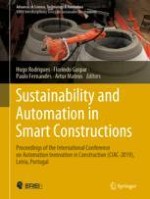2021 | OriginalPaper | Buchkapitel
Modular Construction for Emergency Situation: A Design Methodology for the Building Envelope
verfasst von : Federico Fiume, Nicola Callegaro, Rossano Albatici
Erschienen in: Sustainability and Automation in Smart Constructions
Aktivieren Sie unsere intelligente Suche, um passende Fachinhalte oder Patente zu finden.
Wählen Sie Textabschnitte aus um mit Künstlicher Intelligenz passenden Patente zu finden. powered by
Markieren Sie Textabschnitte, um KI-gestützt weitere passende Inhalte zu finden. powered by
